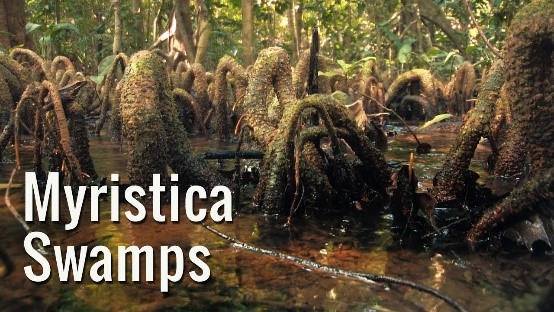Description

Disclaimer: Copyright infringement not intended.
Context
- Myristica swamps, is facing slow and steady degradation, at Sasthanada, Kulathupuzha in Kollam.
Myristica Swamps
- Myristica swamps are a type of freshwater swamp forest predominantly composed of species of Myristica.
- Myristica swamps are called live fossils, a biodiversity hotspot dominated by evergreen trees belonging to Myristicaceae family, one of the oldest flowering plants on earth.
- Myristica swamps have adapted to inundation by way of stilt roots and knee roots.
- Myristica swamps are found in the Uttara Kannada district of Karnataka State and in the southern parts of Kerala.
- Myristica swamps were described as a separate evergreen forest type by Krishnamurthy in 1960.
A living fossil is an extant taxon that cosmetically resembles related species known only from the fossil record. To be considered a living fossil, the fossil species must be old relative to the time of origin of the extant clade.
.jpg)
Degradation of Myristica Swamps
- Myristica swamps, a rare and archaic forest ecosystem largely confined to Kulathupuzha and Anchal forest ranges in Kollam, is facing slow and steady degradation due to multiple factors including man-myristica conflict.
- Degradation of the myristica habitats is a reality as anthropogenic disturbances are increasing in some parts. A motorable road is being constructed from the middle of the biggest swamp in Sasthanada. After the single segment of swamp was torn into two pieces, one part started drying up.
- There has been changes in the species composition.
- In some other areas the construction of check dams for cultivation and watering holes for animals have also impacted this unique ecosystem.
Need of the hour
- Though the swamps are critically in need of conservation, currently there is no consistent monitoring system in place to detect changes.
- Since the ecosystem is endemic to many species, protecting the habitat is very crucial for their regeneration.
- Experts recommend different strategies that include minimising anthropogenic disturbance, regulating visitors, preventing the invasion of non-swampy species and maintaining the hydrological balance of the habitat.
- There is a need to regulate water harvesting from hill streams to sustain the swamps.
- With proper conservation measures they can be protected.
|
PRACTICE QUESTION
Q. Consider the following statements:
1. Myristica swamps are called live fossils.
2. Myristica swamps were described as a separate Deciduous Forest type by Krishnamurthy in 1960.
3. Myristica swamps have adapted to inundation by way of stilt roots and knee roots.
Which of the above statements is/are incorrect?
A) 1 and 3 only
B) 2 only
C) 3 only
D) All
Answer: B) 2 only
|












